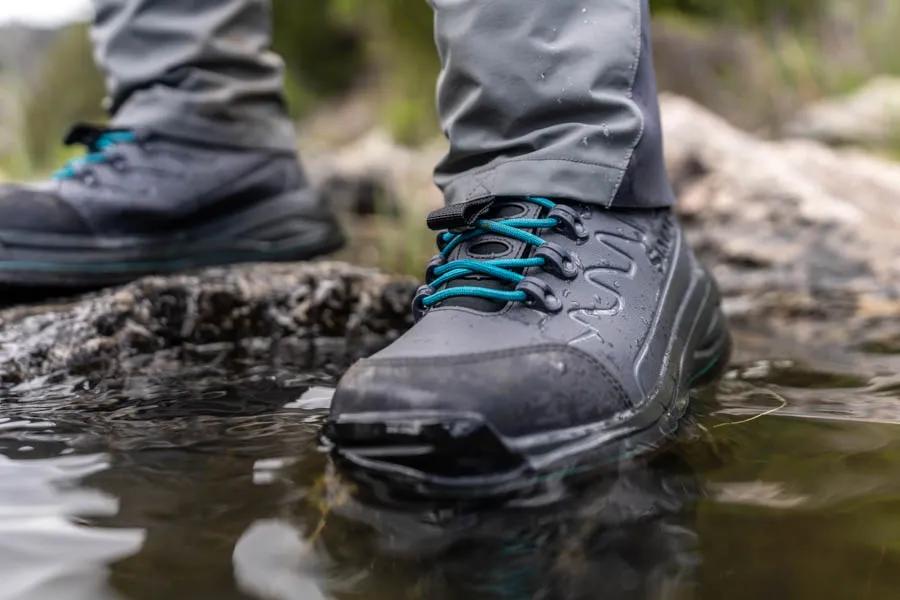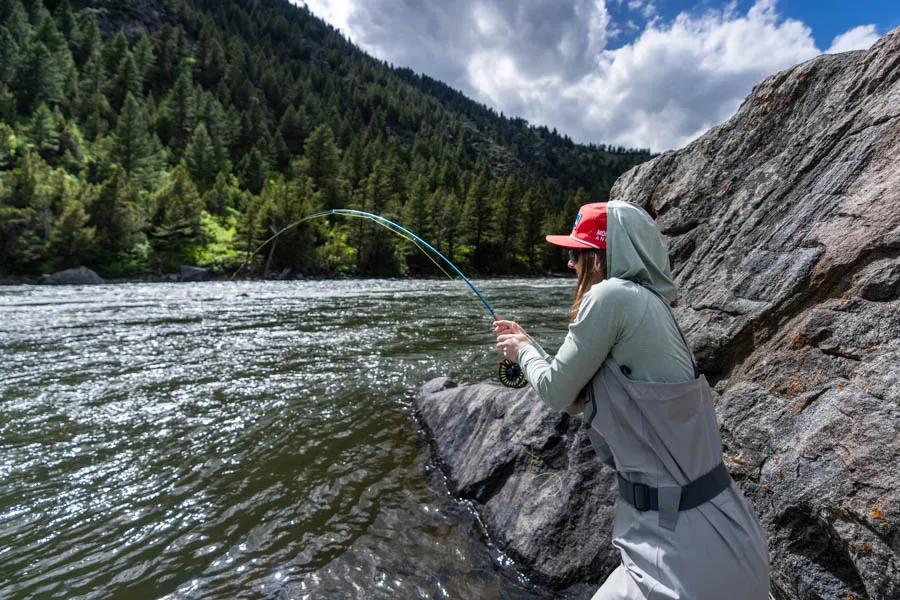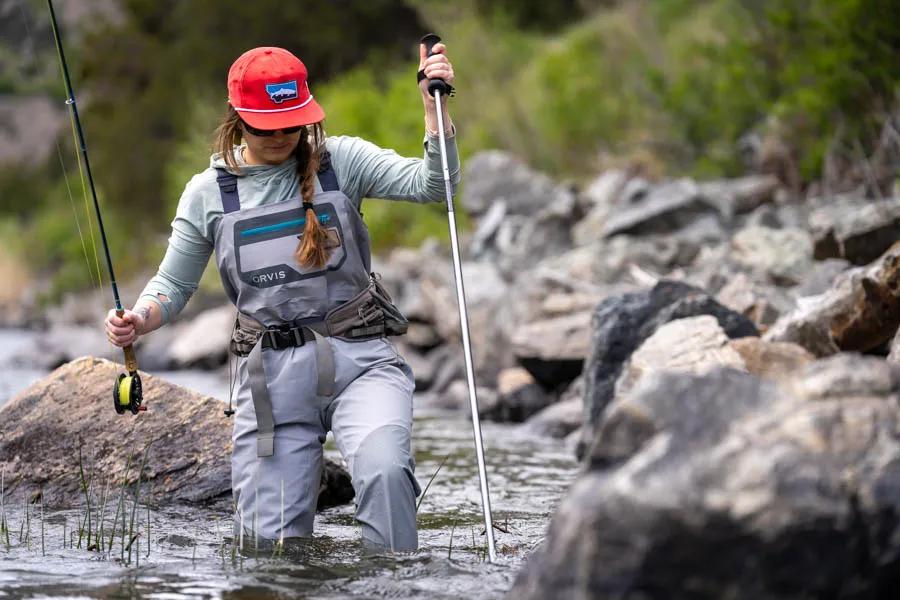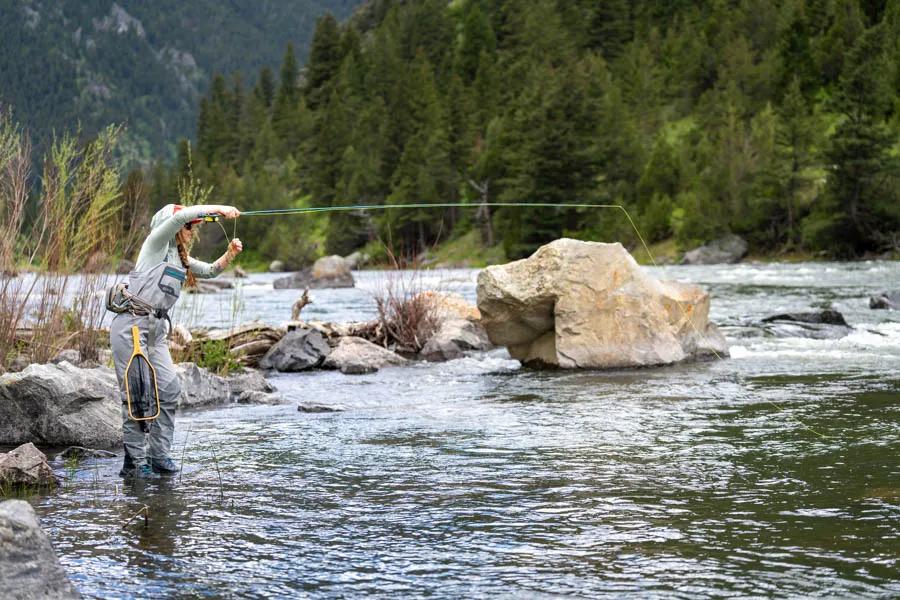
River canyons conjure up angling adventure: Yankee Jim, Bear Trap, the Gorge, the Black Canyon, Land of the Giants, and the Narrows are a few of the named canyon sections of some of the great fly fishing rivers for trout. In these canyons lie some of the most productive fly fishing waters in the West. In Montana alone nearly every of the Ten Best Fly Fishing Rivers have a canyon section, and an isolated canyon as well. Fly fishing big canyon water can be exhilarating, productive, and at certain times of the year a tad bit risky. The rewards of solitude and fishing action in canyon waters are best attained with a little pre-planning and honing of some special skills and casts.
Here are some top tips for fly fishing big canyon waters when fly fishing in Montana.

Gear Up Appropriately
From choosing the correct rods, to wearing proper footwear and functional waders or quick drying pants, fly fishing gear for fishing canyons is specialized. First, choosing the correct fly rods and reels, are crucial to success. Some of the guides at Montana Angler always take two rods when venturing into a remote canyon. They do this because when fishing a deep hole or run in a secluded canyon they like to have a heavier weight rod such as a long six weight or seven weight loaded with a fast sinking sink-tip line. This allows them to get the fly down deep and fast. A wading staff is always a good idea when fishing rocky banks and boulder-filled canyon waters. Whether floating or wading, wearing quality wading boots is important for being able maneuver to the best fishing spots but also crucial for safety to avoid slipping and causing injury.

Choosing the proper footwear is an important component of fishing big canyon water. Whether you choose felt or rubber sticky soles could depend on regulations. Many experienced canyon anglers also invest in studs or cleats placed into the rubber soles. If fishing during high summer and waders are too hot and bulky, wear a quality pair of quick-drying activewear pants. This helps prevents nicks and scrapes when bushwhacking.

Learn to Fight Big Fish
Many canyon rivers for fly fishing in Montana are also home to large trout. Because fly fishing canyon rivers often requires some extra effort—long hikes, jet boat rides, overnight camping trips, whitewater rapids, etc—be sure to know what to do when you hook into a big trout. When hooked, a large fish will fight for its life. Be ready, but also be patient. First, make sure the hook is set with purpose, using either a strip-set when streamer-fishing, a deliberate rod-tip set if dry-fly fishingm or an aggressive downstream angled set if subsurface nymphing. If the fish wants to run, let it run, but keep sideways or downward pressure against the direction of the run. During this time, it’s crucial that your rod tip is allowed to bend. When you feel the fish begin to ease its fight, apply increasingly stronger pressure, and reel in line in between bouts of pressure.
At any moment, be ready to let the fish run again. It’s also a good idea to switch the angle or direction of pressure during the fight. This helps to tire and disorient the fish more quickly. When you can easily switch the angle or direction of pressure, the fish is ready to land. To gain control of a big fish for landing, bring its nose and eyes slightly out of the water—if you can do this close enough to slip a net under the fish, you’ve got it!

Fish With a Partner for Safety, Fun, and More Success
Many canyon sections lie in remote areas out of cell range or essential services. A canyon by nature is defined by steep and difficult to access waters and habitats. Additionally, most of Montana’s fly fishing rivers' canyons feature fast and big water—deep holes, large waves, and minimal shoreline on which to stand. Fishing alone on a small spring creek or tailwater river wouldn’t be considered risky, but hiking alone into a deep rocky canyon with steep cliffs and boulder-filled runs and holes is fine…until it isn’t.

Seclusion and solitude are a big reason we love fly fishing here in Montana, but when fishing big canyon water choosing a good angling companion is never a bad idea. A good angling companion can add enjoyment by providing fun company but they can also offer assistance when getting in or out of the water or netting a large fish if you find yourself in a precarious place with little room to move. They might also be able to offer up a hot fly or even be able to sight a rising or feeding fish from higher up a steep bank.

Wade Safely
When targeting the abundance of enticing trout lies that exist in most canyon waters, practicing proper wading techniques is essential. Because many fly fishing canyons in Montana are strewn with a mix of pocket water, deep holes, and large boulders, depth can change from six inches to sixteen feet with one step. Walking along the shore also requires a slow and steady approach. Boulders and sharp rocks on the riverbank can appear sturdy, but the forces of water can dislodge and degrade rocks over time. Before each step always check to make sure the rocks at your feet are stable before placing your next step or putting your entire body weight over your foot. Polarized glasses are immensely helpful for wading safely. A wading staff is also a very important tool for ensuring you don’t take a bad step and cause injury to yourself or your gear.

Fly Box Organization
Whether float fishing a canyon river or venturing on foot, organizing and pairing down your fly selection helps in a variety of ways. By combing a variety of patterns into one fly box you can carry less in your pack or vest. When fishing from a boat, having all of your flies in one box is very helpful because you know exactly which fly box—ideally the only fly box—to quickly grab if you are busy on the oars or not wanting to miss out on any prime water. When considering what flies to put in your fly box, take into account the season and current conditions at the time. For example, if you are fishing a canyon in late spring or early summer you can sub out grasshopper patterns and replace them with beadhead Prince nymphs or aquatic worms or more stonefly nymphs. If you are wading into the Bear Trap Canyon outside of Bozeman, Montana in winter leave the PMDs and salmonflies at home and bring scuds, sowbugs, and various nymphs, but if you are going in June you need to make sure you have Pat’s Rubberlegs and plenty of large dry flies.

High Stick Techniques
Fast, boulder-strewn waters are common in most canyons and learning some basic casts is essential. Long casts are not always required when fly fishing in Montana’s canyons. More important than a long cast is a good drift. Common in canyon sections are a variety of boulders, seams, and runs. By using the “high-sticking” technique when fishing a canyon, that allows your fly to remain in the feeding zone longer because your fly line is being held out of the currents between your body position and your leader. A few key components of proper high sticking are to hold your wrist and forearm parallel with your rod and begin your high sticking immediately after your fly lands on the water.
Tension Cast/Water Haul Cast
A traditional fly cast requires a back cast without any blocking obstruction behind. When walk-and-wade fishing in a Montana canyon, a normal backcast is often hindered more than it isn’t. Fishing from the bank is common because of quick depth changes that make wading into the river and casting towards the bank difficult. When casting while standing on the bank or with a steep bank behind you, your backcast can often times severely limited. When this occurs, a tension cast, also called a water haul cast, is crucial. A steeple cast can also work, but a tension/water haul cast will perform better when fishing upstream while wading near--or on--the bank.
When wading, begin by allowing the current to carry the fly line downstream of your standing position. Once the line has straightened out below you, use the tension of the current on the fly line to help you reposition the line upstream of you. Raise your rod hand to about head height and turn your palm upward to the sky. Then accelerate the rod forward and stop it as if in a normal forward casting motion.
When you’re in a boat, the cast is performed in two parts—first, a “reverse” tension cast by starting with the fly line on the water in front of you without any slack on the water, then accelerating into a back casting motion, allowing the fly line and flies to land on the water behind you. Then, with a very short pause, go into a forward cast while the tension of the current behind you on the fly line and flies helps you reposition the forward cast.

Fly fishing in a canyon can be a uniquely invigorating experience. With many canyons featuring big boulders, runs of pocket water, and multiple riffles, many cabins feature plenty of healthy habitat for trout. When going on a fly fishing trip to Montana, whether you are fishing the Madison or Missouri Rivers, fishing with a guide on the Yellowstone or Smith Rivers, or venturing deep into the heart of Yellowstone National Park, learning to properly fish the big water of our spectacular canyons will help you be more safe and enjoy more success.
